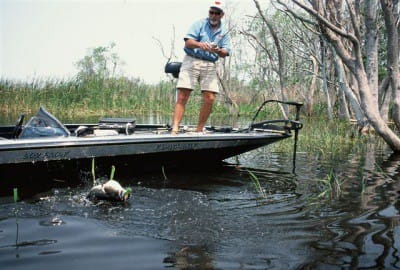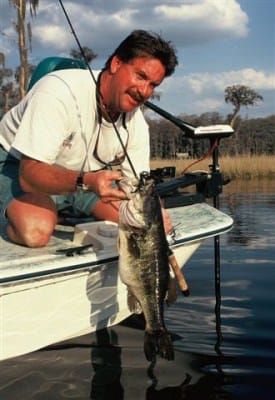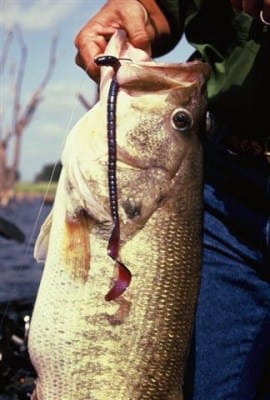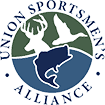
Some anglers believe the heyday of fishing for trophy largemouth bass on public lakes is over. They think a trophy bass of, say, 8-pounds or more, is about as impossible to catch as a crooked politician. But that, thankfully, is not true.
Catch and release fishing, slot limits and better management on many waters has made for outstanding bass action in a number of areas, especially in Florida. Bass fishing in Florida is particularly from late winter through spring, where the fishing is still choice on selected waters. The following five public Florida bass waters offer a great chance for that bass of a lifetime. Throw in a little sunshine and relaxation, and a Florida bass-fishing trip is a great option this time of year.
1) Lake Santa Fe: Lake Santa Fe hasn’t received the national publicity many Florida bass waters have. But the 4,700-acre spring-fed lake in northeastern Alachua County east of Gainesville should, because Santa Fe is as good as any largemouth spot in north Florida. It produces many, many 8- to 10-pounders, and fish considerably bigger are landed annually.
It’s the offshore structure Santa Fe offers that excites many veteran anglers, though the lake has excellent shoreline grass lines and plenty of deep, flooded cypress trees. Santa Fe has one of the deepest shorelines of any Florida lake, with 6 to 8 feet common along outside grass edges. Anglers trolling shiners 50 to 100 feet off grass lines typically are in water 8 to 12 feet deep, ideal for heavyweight bass. Moreover, weedless-rigged plastic worms, tube lures, spinnerbaits and weedless jigs score well when fished to the sparse, irregular and deep grass edges. Crankbaits like Rat-L-Traps do well, too, around deep cypress knees and in the many open-water cuts that angle back into grass lines.
Throughout much of 7-mile long Lake Santa Fe , shoreline weed beds are anywhere from 50 to 200 feet wide. They’re deep and not matted (prime for spinnerbaits and weedless spoons), and there are numerous deep cypress trees and stalagmite-like cypress knees providing choice bass cover. Further, because the water is dark tannin-stained, electric motor-clogging hydrilla isn’t too bad, so an angler can maneuver his boat easily in the reeds. In fact, during spring, bass spawn en masse in the comparatively-open vegetation. Wide cuts in grass make for great spring bassing, especially for anglers flippin’ and sight fishing with tube jigs and finesse worms. On the lake’s east and south shores, and in adjoining Little Santa Fe Lake (1,100 acres on the north side) there are many boat docks and piers extending well out into the reed line, which make superb bass habitat.
Heavyweight largemouths relate well to Santa Fe’s very discernible offshore structures. The late, legendary guide, angler and fish camp owner Roy Griffin used to slow-troll shiners in deep, open water religiously on Santa Fe. He always told anglers he knew to get out far away from the bank, fishing open, deeper water where the lake’s lunkers lived. Griffin and his customers caught countless 10-pound plus largemouths from Lake Santa Fe, Little Santa Fe and Lake Alto (about 800 acres, accessible via a shallow 5-mile canal off the west side of Little Santa Fe, or by boat ramp off S.R. 325). Although Griffin didn’t catch the 16-pound Santa Fe record, he is credited with boating a 14-pounder and a 14-pound, 2-ounce behemoth on consecutive days of spring trolling with shiners in deep, open water.
Griffin’s technique was to troll baits over sandbars (the best ones have deep weeds) that irregularly rise up from the lake floor 150 to 250 yards offshore. In many places there’s 6 to 8 feet of water over sandbars with 12 feet of water between the bars and shoreline, tapering down to 30 feet in places offshore the bars. The sandbars are not continuous around the lake. In fact, in some places they are more like “humps” or submerged islands. But such deep, open-water structures are available throughout much of the lake, and even a base knowledge of using a fathometer can put an angler into outstanding, vastly untapped Florida big bass water.
2) Lakeland Lakes: While lots of large Florida lakes get notable publicity for giving up bass, it’s likely more lunker largemouths are caught by more people from small, virtually unknown waters. That’s especially true near the town of Lakeland, where small 50- to 1,000-acre lakes dot the landscape like craters on the moon. Many are readily accessible, but most aren’t fished hard, except by a few hard-charging anglers like guide and BASS Classic competitor Carroll Hagood, who believes some of the best bassing in America is found near his home area of Lakeland on waters such as 500-acre McLeod Lake where he regularly catches 8- to 10-pounders every spring.
“McLeod is a great bass lake because it doesn’t get much fishing pressure since there are so many other outstanding waters nearby that get so much publicity,” explains Hagood. “Most out-of-state anglers coming to Florida still head to the big lakes like Okeechobee, Kissimmee and George. Recently some of the ‘hot’ lakes like the Stick Marsh and Istokpoga have taken some of that pressure, too. But for every lake like Istokpoga there are 50 other, smaller lakes like McLeod that have sensational bass fishing that are rarely fished by serious anglers, particularly non-residents.

“Those little lakes of 300, 500, even 1,000 or 2,000 acres just don’t get lots of publicity. A lot of them don’t have marinas or fish camps, and most are within just an hour drive of Lakeland, which is one reason I live, guide and fish there. Some huge bass are caught from these lakes every year, big numbers of 8 to 10-pounders, and fish to 13 and 14 pounds are taken annually. Most have great launch access and are not difficult to fish.”
While McLeod is one of Carroll’s favorite Lakeland area bass waters, there are many more. Adjacent to Lake McLeod, for example, is 650-acre Eagle Lake. Carroll rates it as good as McLeod, with plenty of 8- to 10-pound bass. It has clear water, like McLeod, which Hagood desires for spring bassing because sight fishing for largemouths can be done so easily. He rates it a top summer lake, too, which often teems with giant schools of surface-feeding largemouths, some of which occasionally weigh 5 or 6 pounds. Another plus for Eagle Lake, just like McLeod, is that it has an excellent boat ramp for easy access, and it’s well sheltered from wind, which is an important asset for winter-spring fishing that often is bothersome on sprawling Florida waters like Kissimmee, Toho and Okeechobee.
A little to the north, off Highway 17, is 700-acre Lake Alfred. This picturesque lake is where Carroll cut his bass fishing teeth, and he says it’s about as good today as it was 30 years ago when he fished it as a youngster. Hagood has caught countless big bass from Alfred, including many over 10-pounds. His best from the clear-water lake is a 13-pounder he hooked on a shiner. He rates it a choice winter spot, especially for anglers slow-trolling live shiners. It’s clear, but full of shallow vegetation such as bulrushes, lily pads, and there are beds of bass-holding hydrilla weeds. Some shoreline areas have flooded cypress trees and peppergrass, and serious bass angling pressure is light.
Another top bass spot located right in the city limits of Lakeland is 2,200-acre Lake Parker.
“This is really two lakes, Parker and Cargo Lake, which connects to Parker,” Carroll explains. “Parker is a power plant lake, so the hot-water discharge keeps it warm, which makes it a dandy winter lake. It’s full of bulrushes, and that makes it one of the best flippin’ bass lakes I’ve ever been on. There are a lot of heavy bass. And when you roll a good one weighing 8 pounds or more right at your feet while flippin’, well, it’ll make Parker a name you’ll always remember.”
Parker is bowl-shaped and shallow, while Cargo is deep. Most fishing pressure is had in winter, which is when most local bass club tournaments are held there. Carroll has seen winter tournaments on Parker that took a limit of 8-pound bass to win! While the lake is somewhat clear, it’s not so clear as to rate it as one of Carroll’s favorite for sight fishing for bedding bass. He says flippin’ and working crankbaits around drop-offs is more productive. When hydrilla weeds are available, they’re a key fishing location. Spinnerbaits, hard-plastic jerkbaits and Slug-Gos are hard to beat for boating good Parker bass.
Other Lakeland bass waters worth tapping include Saddle Creek lakes located just east of Lake Parker; 3,000-acre Lake Marion near Haines City: Pierce (3,700-acres), located just south of Marion; Reedy Lake (3,500 acres) near Frostproof; Lake Arbuckle (3,800 acres) east of Reedy; Lake Hamilton (2,100 acres) southwest of Haines City; Lake Vann (600 acres) north of Auburndale; and Lake Fannie (700 acres) just northeast of Winter Haven.
3) West Lake Tohopekaliga: This 22,000-acre central Florida lake (south of the town of Kissimmee and west of the town of St. Cloud) has long been one of the state’s better-known waters. Simply because it’s one of the most productive for truly bragging-size bigmouths. Few lakes anywhere, even in Florida, have given up more bass weighing over the magic 10-pound figure as Tohopekaliga, and over the years plenty of 14 and 15 pounders have been plucked from the remarkable lake.
Peak time for outsize Tohopekaliga (better known as “Toho”) largemouths is mid-December to mid-March. Anglers score best on big bass by fishing live shiners 18-inches below cork floats, tight to bulrush and grass beds, generally in boat trails and in natural cuts through Toho’s labyrinth of aquatic growth. Anglers often locate schools of big bass, and catch several trophy fish from a single anchored position.
The south end of the lake is favored by many Toho anglers, but in February and March Toho’s north end heats up for big bass, too. Some favored spots for stout largemouths include the: Browns Point, North Steer Beach and Whaley’s Landing areas.
April and May are good months to catch 2-to-4 pounders from Toho on plastic worms, 3/4-ounce Johnson Weedless Spoons and Lunker Lures, especially in lily pads near North Steer Beach. But these two spring months aren’t great for trophy-class fish. Fishing for heavy bass stays kind of slack until June, then it picks up pretty well all through the month. In the hottest parts of the summer there’s great fishing, too, with the best of it had around mid-day hours during full moon periods. The whole month of October is good, also. Many bass from June through October are caught on plastic worms, usually working them in 4 to 6 feet of water along outsize edges of weed beds.
Wade fishing on Toho is a deadly system to catch big bass from the lake’s shallows. Anglers typically run to a choice area, get out, wade and cast. Sometimes an angler will tie the boat to his waist with a bow line and tow it 30 to 50 feet behind him. Other times the boat is merely anchored in shoreline weeds while the anglers prowl the immediate area. Wading works on Toho better than many lakes because Toho is extremely shallow, averaging only 6 feet deep. And almost all big fish relate to shoreline grass, bulrush, maiden cane and lily pad beds, which often can be best approached and fished via wading. But Toho wading is not meant for the faint-hearted. The lake is alive with alligators, and there are plenty of cottonmouth water moccasins.
For fishermen who forego wading, flipping with plastic worms and weedless jigs is almost as effective. Flipping really shines during cold fronts and in the blistering summer sun when Toho largemouths hug tight to thick weed bed edges and are reluctant to move far or fast to feed.

4) Rodman Reservoir: This 14-mile long, 3-mile wide, 17,000-acre clear-water reservoir is by no means an “overlooked” Florida bass spot. For many years anglers from around the world have thronged to Rodman to catch its heavyweight bass. But unlike most “old” lakes, Rodman continues to give up tremendous numbers of heavyweight bigmouths. Rodman is a unique Florida fishery, because it’s a dammed portion of the Oklawaha River (that feeds the famous bass-filled St. Johns River) and is part of the now halted Cross Florida Barge Canal.
Located in north-Florida, near the towns of Interlachen and Welaka, the lake is a jungle of fallen trees, twisted roots, stumps, and floating and submerged weeds, all of which provide cover and food for bass. This is what has allowed Rodman to withstand tremendous fishing pressure over the years, though today most big bass are released.
For Rodman’s broad-back bass nothing is better than large, “native” shiners. They are especially productive when they’re “run” under floating beds of weeds that stack along the outside bends of the old Oklawaha River channel in the lake’s flooded timber. Shiners also take big mossbacks when they’re fished from floats and anglers drift across stump flats from the lake’s dam to the flooded trees. Plastic worms and floating-diving plugs take fish early and late in the day in the same areas.
Rodman annually gives up thousands of bass weighing 5-pounds or more. Ten-pounders are not unusual. One March day angler Melvin Carter caught a 15-pound, 2-ounce behemoth from Rodman with guide Dave Perkins. Also with Carter that day were his son Darren and Buzz Tyre, all of Jacksonville. In addition to Carter’s 15-pounder, the anglers also had a 9 1/2-pounder, and three other bass over 10 pounds, including an 11 1/2-pounder.
Three days later, E.C. “Doodle Bug” Dressler, a visiting fisherman from Covington, Virginia, caught a 17-pound, 2-ounce largemouth from Rodman, one of the largest bass ever officially weighed in the Sunshine State. Dressler was fishing with his pal, Bill McConnell.
Marina, lodging and restaurant facilities on Rodman are sparse. Most visiting anglers headquarter in the nearby towns of Palatka or Welaka, which have many motels and restaurants. Anglers can launch boats into Rodman at several free public ramps around the lake. Bassmen also can run into Rodman through locks in the Cross Florida Barge Canal that links the lake with the famed St. Johns River. Rental boats and motors are not available on the lake.
Guide Jim Romeka (phone 904-291-8052) specializes in Rodman bass action.
5) Lake Walk-In-Water: The Indians named it Lake Weohyakapka. But for ease of pronunciation, locals call it “Lake Walk-In-Water.” Fishermen in the know, however, call the spot one of the best bass fisheries the Sunshine State has ever seen. Even the state fisheries department recognizes the lake south of Orlando and Lake Kissimmee as one of the most remarkable big bass fisheries Florida has had in many years.
“The numbers of 8- to 12-pound largemouths Weohyakapka produces is absolutely incredible,” guide Johnny Doub says shaking his head. “I’ve had days of slow-trolling wild shiners when a guide party and I have caught over five such huge bass, including three fish each over 10 pounds.”
Such talk about big bass on a public lake smack in the heart of Florida and near major tourist centers may sound like hyperbole, until it comes from someone like Doub, a guide with over 25 years of big fish experience. He says best fishing is spring and fall, but he produces huge bass for clients right through the summer months. Key to the lake’s big bass productivity is hydrilla, big beds of it in deep water, 6 to 9 feet down. It’s full of bait and big bass.
Doub is available for guided trips by phone at 863-692-1668.







